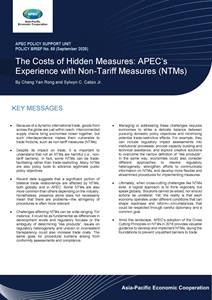
Proceedings
APEC Workshop on Promoting Decarbonization of Power Sector by Using Carbon-Free Energy (CFE)
The Asia-Pacific Economic Cooperation (APEC) is a regional economic forum established in 1989 to leverage the growing interdependence of the Asia-Pacific.
The Asia-Pacific Economic Cooperation (APEC) is a regional economic forum established in 1989 to leverage the growing interdependence of the Asia-Pacific.
APEC ensures that goods, services, investment and people move easily across borders. Members facilitate this trade through faster customs procedures at borders; more favorable business climates behind the border; and aligning regulations and standards across the region.
APEC ensures that goods, services, investment and people move easily across borders. Members facilitate this trade through faster customs procedures at borders; more favorable business climates behind the border; and aligning regulations and standards across the region.
APEC works to help all residents of the Asia-Pacific participate in the growing economy.
APEC works to help all residents of the Asia-Pacific participate in the growing economy.
Capacity building projects play an important role in helping translate APEC's goals into reality.
Capacity building projects play an important role in helping translate APEC's goals into reality.

Reports
•September 2025
Download Report
876KB
Published Under
APEC Secretariat, APEC Policy Support Unit
Accessed
575
Pages
13
Interconnected supply chains bring economies closer together and foster trade, but such interdependence could make them more vulnerable to trade frictions, such as the implementation of non-tariff measures (NTMs) that restrict trade. However, not all NTMs are harmful. Many serve as policy tools to advance legitimate public policy objectives. Moreover, the presence of NTMs alone does not necessarily mean that there are problems—the stringency of procedures is often more relevant. Against this background, challenges affecting NTMs can be wide-ranging. Managing or addressing these challenges requires economies to strike a delicate balance between pursuing domestic policy objectives and minimizing potential trade-restrictive effects.
The implementation of any NTM inherently involves two economies, one that enacts the measure and the other that is affected by it, and implementing it could involve the participation of several government institutions. In this context, solutions cannot be siloed. Inter-institutional coordinations and dialogues between governments are required. Amid this landscape, APEC’s adoption of the Cross Cutting Principles on NTMs in 2018 provides valuable guidance to develop and implement NTMs, laying the foundations to prevent unjustified barriers to trade.
This policy brief draws insights from APEC’s experience with NTMs and highlights challenges that economies often face. It also provides a set of policy approaches to help policymakers manage these challenges.

